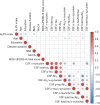Association between body mass index and glymphatic function using diffusion tensor image-along the perivascular space (DTI-ALPS) in patients with Parkinson's disease
- PMID: 38545038
- PMCID: PMC10963810
- DOI: 10.21037/qims-23-1032
Association between body mass index and glymphatic function using diffusion tensor image-along the perivascular space (DTI-ALPS) in patients with Parkinson's disease
Abstract
Background: Obesity is considered a risk factor for the development of several neurodegenerative diseases, including Parkinson's disease (PD). Recent studies have revealed that glymphatic function is compromised in PD patients. This study aims to investigate the impact of different body mass index (BMI) statuses on glymphatic system function in PD patients using the diffusion tensor image analysis along the perivascular space (DTI-ALPS) method.
Methods: This study used a cross-sectional study design. A total of 145 PD patients were retrospectively enrolled in Parkinson's Progression Markers Initiative (PPMI) from 2010-2013. Eligibility criteria included diagnosis of PD based on PPMI criteria. Diffusion tensor image (DTI) scans (diffusion gradient =64, b-value =1,000 s/mm2, slice thickness =2 mm) were acquired, and the analysis along the perivascular space (ALPS) index of each subject was calculated. The patient cohort was categorized into three groups based on BMI: normal weight (N=49), overweight (N=69), and obese (N=27). The difference in ALPS index among groups was performed by one-way analysis of variance (ANOVA). Partial correlation analysis was used to observe the relationship between ALPS index, BMI status, and demographics. Spearman's rank correlation coefficient and multivariable linear regression analyses were used to identify factors associated with ALPS index.
Results: PD patients with higher BMI exhibited a reduced ALPS index (normal weight > overweight > obese), and the ALPS index for patients with obesity was statistically significantly lower than that for patients with normal weight (P<0.001). After adjusting for age, sex, years of education, handedness, and disease duration, a significant negative correlation between the ALPS index and BMI was observed in the PD patients (R=-0.275, P<0.001). Furthermore, a negative correlation between the ALPS index and the severity of motor symptoms was identified in the subgroup of overweight (R=-0.318, P=0.01), rather than in the normal weight and obese groups.
Conclusions: High BMI has a negative impact on the glymphatic function in PD patients, suggesting that weight control may have clinical relevance in the management of PD patients.
Keywords: Body mass index (BMI); Parkinson’s disease (PD); diffusion tensor imaging; glymphatic system.
2024 Quantitative Imaging in Medicine and Surgery. All rights reserved.
Conflict of interest statement
Conflicts of Interest: All authors have completed the ICMJE uniform disclosure form (available at https://qims.amegroups.com/article/view/10.21037/qims-23-1032/coif). The authors have no conflicts of interest to declare.
Figures





Comment in
-
Obstructive sleep apnea as a possible mediator for the association between glymphatic function and body mass index in Parkinson's disease.Quant Imaging Med Surg. 2025 Aug 1;15(8):7674-7675. doi: 10.21037/qims-2025-1124. Epub 2025 Jul 24. Quant Imaging Med Surg. 2025. PMID: 40785875 Free PMC article. No abstract available.
References
-
- Ota M, Sato N, Nakaya M, Shigemoto Y, Kimura Y, Chiba E, Yokoi Y, Tsukamoto T, Matsuda H. Relationships Between the Deposition of Amyloid-β and Tau Protein and Glymphatic System Activity in Alzheimer's Disease: Diffusion Tensor Image Study. J Alzheimers Dis 2022;90:295-303. 10.3233/JAD-220534 - DOI - PubMed
-
- Taoka T, Masutani Y, Kawai H, Nakane T, Matsuoka K, Yasuno F, Kishimoto T, Naganawa S. Evaluation of glymphatic system activity with the diffusion MR technique: diffusion tensor image analysis along the perivascular space (DTI-ALPS) in Alzheimer's disease cases. Jpn J Radiol 2017;35:172-8. 10.1007/s11604-017-0617-z - DOI - PubMed
LinkOut - more resources
Full Text Sources
